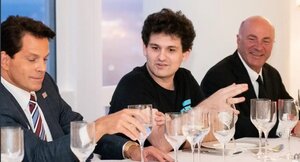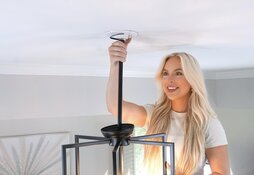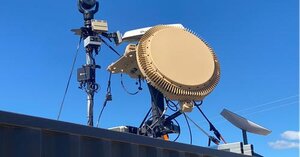After well over a year of ongoing conflict in Ukraine, a second major front of unleashed global conflict erupted in and around the Gaza Strip at the beginning of October. In addition to confirming age-old wisdom about war (e.g., that it is hell), these modern conflicts are teaching us new lessons about the cadence of futuristic battlefield wreck-and-replace rates, as well as the demoralizing effects such heightened operational tempos can exert on forces on both sides of the equation.
Reporting for The Daily Beast, David Axe wrote on October 28, "Look closely at photos of the Israeli army mobilizing for a possible incursion into Gaza. . You might note strange, cage-like metal roofs welded or bolted onto the tops of Israeli Merkava tanks. Soldiers call this add-on armor a 'cope cage,' as it's designed to cope with a new and devastating weapon: a toy drone."
The 'cope cage' moniker is designed to be derisive and humorous, underscoring the deadly accuracy and brutal shift in power that the wide adoption of small drones by fledgling military forces has occasioned. These cages are notoriously ineffective against current drone tactics, providing little more than a psychological defense for the troops they "protect."
According to Axe's article, "A decade after Iraqi, Syrian and Yemeni militant groups first weaponized quadcopter-style drones — strapping explosives to them for one-way 'kamikaze' attacks or rigging them to drop grenades — cheap drones are now the standard aerial weapon for both the Russian and Ukrainian armies."
"Likewise, Hamas deployed drones during its October 7 attack, damaging at least two Merkava tanks by aiming for the weak points in the tanks' top armor — the same weak points the hastily produced cope cages are meant to protect. Earlier cope cages protected tanks from missiles that were designed to strike the vehicles on their roofs; armies assumed the cages would also work against drones."
The Catalyst: Expendability
The wide array of simple-to-use drones currently available has led, according to Axe's reporting, to two basic types of do-it-yourself attack drones. "There are quadcopters or octocopters that drop grenades and are guided by GPS or radio by an operator sitting behind a screen. There are also single-use first-person-view drones loaded up with explosives and steered via radio by an operator peering through a virtual-reality headset."
This variety of vectors makes drones particularly difficult to harden against, as the threat model remains highly mutable and likely to rapidly evolve as successive attack waves are deployed and then analyzed to improve effectiveness. With no human operators' lives at risk in any regular drone attack, a rapid operational tempo can be maintained, with losses measured only in dollars, and each loss offers valuable insights that can considerably improve future missions.
"A typical drone might weigh just a couple of pounds and fly no farther than 20 miles at a top speed of less than 30 miles per hour," Axe explains. "Compared to a supersonic warplane weighing 20 tons and ranging hundreds of miles, a DIY attack drone is flimsy, slow, and short-ranged. But where a fighter jet might cost $50 million, the commonly-used DJI Mavic 3 FPV drone retails for just US$2,000. Military commanders think twice before sending a fighter and its expensively trained pilot into harm's way. They don't have to think at all before launching a drone or a whole swarm of drones."
The numbers seen on the ground reflect this readiness to reiterate the drone strike process on an almost daily basis. According to Samuel Bendett, a senior non-resident associate with the Center for Strategic and International Studies' Europe, Russia, and Eurasia Program, "We are seeing drone saturation on the battlefield like never before."
Why This Sector? Combining the Oldest with the Newest
Axe reports that "Ukrainian drone operators tend to coordinate their attacks with artillery — the newest and oldest weapons on the battlefield, working together. The Ukrainians' artillery fires first, and then the Russians have to take cover because of the artillery. While they're waiting out the barrage, [the Ukrainian commander] is launching his attack drones for the killing blow. 'It wins us time,' [the commander] says of the artillery."
"As it became clear last year how dangerous small drones could be," Axe continues, "the Russians and Ukrainians began installing cope cages on their tanks and other armored vehicles; the Israelis scrambled to do the same following their initial tank losses during the Hamas infiltration."
"Small drones have upended traditional warfare. Before, militaries engaged in a slow technological tit-for-tat. One military would deploy a new weapon, a rival military would develop a countermeasure, and then the first military would modify the original weapon to defeat the countermeasure. So on and so forth, year after year, decade after decade . . . Tiny drones have broken the cycle. They're so cheap, and thus so easy to deploy in huge numbers, that armies are struggling to develop defenses fast enough to prevent devastating drone campaigns."
As you might imagine, the past year's wide international focus on the importance of both drones and drone suppression systems has fostered considerable growth for businesses operating in both those rapidly growing market spaces.
The hard truth is that the demand for anti-drone technology is growing, with a market size projected to reach US$3.8 billion by 2027 from a total of US$1.47 billion in 2023.
Projections from Allied Market Research value the same market at US$1.3 billion in 2021 and expect it to reach US$14.6 billion by 2031. Fortune Business Insights reports the global anti-drone market size as "US$1.34 billion in 2021" and "projected to grow from US$1.58 billion in 2022 to US$6.95 billion by 2029."
DroneShield Ltd.
One company particularly well situated to capture this nascent market is Australian powerhouse startup DroneShield Ltd. (DRO:ASX; DRSHF:OTC), which develops technologies to protect people, vehicles, and installations from drones.
Its artificial intelligence-based platforms for protection against drone threats and other hostile autonomous systems are easily deployed across various terrestrial, maritime, and airborne platforms.
DroneShield provides custom counter-drone and electronic warfare solutions built to specification, as well as off-the-shelf products designed to meet a variety of operational requirements. The company's wide array of products include the DroneGun Tactical, DroneGun MK3, DroneGun MK4, DroneSentry, DroneSentry-C2, DroneSentry-X, and RfPatrol.
The company recently introduced the DroneSentry-X Mk2, a new detection and adaptive disruption system for tracking multi-domain unmanned systems. The DroneSentry-X Mk2 can be mounted to standard vehicle roof racks on military vehicles, surface vessels, and unmanned mobile platforms.
DroneShield CEO Oleg Vornik says the company has seen "explosive growth" this year as it has expanded its U.S. headquarters in Northern Virginia and added top talent to stabilize its production cycle in both continents on which it operates.
With over 90 employees spread across operations in Sydney and Virginia, DroneShield secured an AU$33 million government sale, an AU$9.9 million 2-year R&D contract, and an AU$40 million capital raise in the past few quarters. It has been working through an AU$ 62 million order backlog that's part of an AU $200 million pipeline.
 Streetwise Ownership Overview*
Streetwise Ownership Overview*
DroneShield Ltd. (DRO:ASX; DRSHF:OTC)
The company aims to expand to employ some 120 to 150 staff in the next five years, supporting revenue of AU$300 million to AU$500 million per year, with roughly half of that income generated via software as a service (SaaS) and software R&D channels that are being developed alongside its manufacturing base.
There are 586.9 million outstanding shares, with 496.03 million free-float traded shares. The company has a market cap of US$105.64 million. It trades in a 52-week range of US$0.10 and US$0.34.
Approximately 2.46% of DroneShield is held by management and insiders. Independent Non-Executive Chairman Peter James owns 1.09% of the company with 6.63 million shares, CEO Oleg Vornik owns 1.75% with 10.7 million shares, and Director Jethro Marks owns 0.21% with 1.3 million shares, CFO Carla Balanco owns 1.38% of the company with 8.45 million shares, CTO Angus Bean owns 1.21% of the company with 7.39 million shares.
Institutions own 7.99% of the company. Charles Goode (through Beta Gamma Pty. Ltd. And Ravenscourt Pty. Ltd) owns 3.52% of the company with 21.50 million shares. S R Bennet Pty. Ltd. owns 0.88% of the company with 5.35 million shares, and P & B Shaw FT CB Pty. Ltd. owns 0.56% of the company with 3.43 million shares.
Red Cat Holdings Inc.
Of course, the Anti-Drone market isn't being driven by nothing. Drones themselves are booming, and not just on the battlefield. Red Cat Holdings Inc. (RCAT:NASDAQ)
A recent market report from The Business Research Company explains that "The global military drones market size will grow from US$14.54 billion in 2022 to US$15.88 billion in 2023 at a compound annual growth rate (CAGR) of 9.2%. The Russia-Ukraine war disrupted the chances of global economic recovery from the COVID-19 pandemic, at least in the short term."
The report goes on to say that "The war between these two countries has led to economic sanctions on multiple countries, a surge in commodity prices, and supply chain disruptions, causing inflation across goods and services and affecting many markets across the globe. The global military drones market size is expected to grow to US$20.64 billion in 2027 at a CAGR of 6.8%."
Red Cat Holdings Inc. (RCAT:NASDAQ), which recently doubled its initial order with The U.S. Defense Logistics Agency to US$5.2 million, aims to fill that gaping maw of raw user demand with the type of top-tech drones that DroneShield's best products are designed to ameliorate.
According to Red Cat Holdings CEO Jeff Thompson, "The Air Force needs to secure its airfields and bases 24/7, and our Teal 2 offers the highest-resolution night vision in its class."
The Teal 2, designed as the top unmanned platform for night operations, has been approved by the U.S. Department of Defense for use across the department and others, adhering to its evaluation standards for service. Puerto Rico-based Red Cat has also deployed 200 high-speed drones on behalf of Ukraine and is involved in a US$90 million deal to provide drones for the U.S. Customs and Border Patrol (CBP).
ThinkEquity analyst Ashok Kumar wrote in March, "Looking forward, ThinkEquity expects Red Cat's revenue and operating income to increase. The investment bank estimates revenue will reach US$11.9 million in FY23 and then more than triple to US$37 million in FY24.
According to Technical Analyst Clive Maund, the stock "continues to have the prospect of winning some very big orders for its drones."
He wrote on July 27 that he was staying long on the stock."The company's Teal 2 drone appears to be a 'game changer,' as it has unsurpassed nighttime capabilities."
RedCat Holdings has a market cap of US$56.2 million, with 55.54 million shares outstanding, and trades in a 52-week range of US$1.69 and US$0.7676.
According to Red Cat, 37.27% of company stock is held by management and insiders. Reuters notes that CEO Thompson owns 22.13%. CEO of Fat Shark RC Vision Systems Gregory Ralph French has 8.67%. COO Allan Thomas Evans has 2.41%. Director Nicholas Liuzza has 1.76%. CFO Joseph Hernon has 0.47%, and CEO of Teal Drones George Matus has 0.58%.
Institutional investors have 9.01%. The Vanguard Group Inc. has 2.3%. Pelion Venture Partners has 1.62%. BlackRock Institutional Trust has 0.61%, and Geode Capital Management LLC has 0.49%.
Sign up for our FREE newsletter
Important Disclosures:
- As of the date of this article, officers and/or employees of Streetwise Reports LLC (including members of their household) own securities of DroneShield Ltd. and Red Cat Holdings Inc..
- Owen Ferguson wrote this article for Streetwise Reports LLC and provides services to Streetwise Reports as an independent contractor.
- The article does not constitute investment advice. Each reader is encouraged to consult with his or her individual financial professional and any action a reader takes as a result of information presented here is his or her own responsibility. By opening this page, each reader accepts and agrees to Streetwise Reports' terms of use and full legal disclaimer. This article is not a solicitation for investment. Streetwise Reports does not render general or specific investment advice and the information on Streetwise Reports should not be considered a recommendation to buy or sell any security. Streetwise Reports does not endorse or recommend the business, products, services or securities of any company mentioned on Streetwise Reports.
For additional disclosures, please click here.





































